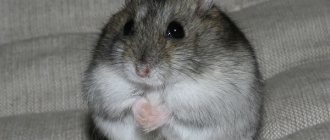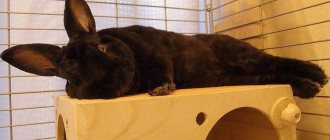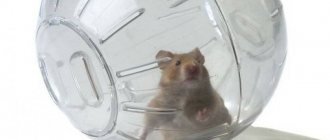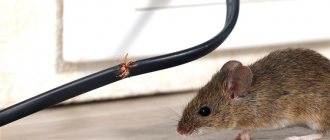The main advantages of keeping a rat
Fortunately, the advantages of decorative rats are much greater than the disadvantages. Below are listed only the main positive qualities of the animals.
High socialization
Rats do not tolerate loneliness very well; they prefer to live in small same-sex groups. At the same time, animals show care for their relatives:
- brush each other's fur coats;
- feed weakened individuals;
- show sympathy;
- warn of impending danger.
Fights and conflicts between rats are a very rare phenomenon, which is observed mainly in males during sexual activity.
High cognitive abilities
Contrary to popular belief, rats are very smart. Their intellectual abilities are on par with cats and dogs. Rodents remember their name well and are easy to train.
Fluffies can be taught on their own such commands as “give me a paw”, “lie down”, “come to me”. Rats also perform simple tricks - walk on their hind legs, roll a ball, spin around their own axis, jump from place to place.
Easy to care for
The cute fluffies are quite easy to care for. Difficulties may arise at first, but the main thing is to get used to it. By choosing a cage with a removable tray, cleaning takes literally 10-15 minutes.
Sawdust or shredded toilet paper are used as filler. You can feed your rodent either specialized food or natural food. The only caveat is that you need to remember the list of prohibited products.
Doesn't take up much space
Decorative rats are quite compact. Their body length is about 20 cm. Therefore, several individuals can be kept in one multi-tiered cage at once - up to 5-6 pieces. The rat house itself does not take up much space. The cage will easily fit on a desk or bedside table.
Affordable price
The price of a decorative rat, even one raised in the most prestigious nursery, is unlikely to rise above 2,000 rubles. And at the poultry market or by hand you can buy a purebred pet for only 500-700 rubles.
It is better to buy rats from professional nurseries. Because pups raised by experienced breeders are more socialized and healthier.
Easy to transport
Rats tolerate moving well even over long distances. All that is required for comfortable transportation is a special carrier with a secure lock, while ensuring air circulation. The small weight of the animal - within 500 grams - will prevent the owner from getting tired during the trip.
Big choice
There are many breeds of decorative rats, so everyone will find a pet to their liking. Among the varieties there are different animals: compact and bulky, bald and fluffy, with straight and curly hair, with large and small ears, albino and fluffy with complex colors.
Cleanliness
Many people believe that the destiny of rats is to climb through garbage dumps and rummage through garbage. However, ornamental animals are very different from pasyuki. Cute fluffies are very clean.
They perform daily activities to maintain the cleanliness of their body: they wash themselves after each meal and lick their fur. And if several individuals live in a cage, they happily clean each other’s fur coats. In addition, decorative rats love to swim. The owner must take care of organizing water procedures.
Attachment to the owner
Rats quickly get used to their new owner and happily spend time with him. In addition, cute animals gradually get used to the rest of the family members. If a rodent feels good about itself, it will never bite, scratch or run away from home.
Possibility of litter training
Rats are very smart, so they can be trained to go to the toilet in one designated place. This will only require a few trays (according to the number of pets in the cage) and a little patience.
The duration of toilet training is from 2 to 4 weeks. If the rat gets used to the litter box, the process of cleaning the cage will take much less time.
Activity
Decorative rats are very active - they really like to play with their relatives, exercise on apparatus in the cage, and explore everything new. It is very interesting to observe the life of fluffies from the outside. If you have free time, you can spend hours on end watching cute animals frolic.
Since rats are very active, it is better to purchase multi-tiered cages for playful animals. 2-3 floors will be enough for males, 4-5 tiers for females.
No need to spend a lot of time together
Rats love their owners very much and are always willing to play with them. But if the furry owner doesn’t have much time to spend together, it’s okay. Fluffies are able to keep themselves busy - they exercise on apparatus, play, and frolic with their cage neighbors. At the same time, the rodent does not develop any resentment towards humans.
No need to go outside
Other pets, such as cats and dogs, need a lot of space. In addition, such large pets prefer to go to the toilet outside.
With rats everything is much simpler. The little animal feels quite comfortable in a cage. And to release the accumulated energy, a play complex installed in a cage is enough for a rodent.
Is it true that they are marking territory?
Many people report that they leave drops of urine everywhere. This behavior is quite normal, this is how rodents mark their territory and this is inherent in nature.
The fact is that urine contains a huge amount of information that they leave for their relatives.
They not only mark their territory, but also convey information regarding age, social status, sexual maturity and the presence of stress. Marking territory is more characteristic of males, but females are no exception.
Owners often cover them with a special fabric during walks to protect carpets and furniture from such “fragrant” marks.
There are situations when animals urinate on themselves, but this does not apply to marks at all, it is a sign of a disease and you should definitely contact a veterinarian. Apart from the issues with marks, in general they are very clean and easily litter trained.
Cons of content
Unfortunately, rats do not have their drawbacks. But the shortcomings of these cute rodents are very minor, and they can be easily dealt with.
Tendency to diseases
Rats have a fairly weak immune system, so fluffies often get sick. In addition, a predisposition to certain diseases is inherent in them at the genetic level. Most often, rodent owners encounter the following ailments of their pets:
- ARVI;
- malignant and benign neoplasms;
- mycoplasmosis;
- atherosclerosis;
- renal failure;
- pneumonia.
Rats also often suffer from fleas, lice, ticks, worms and other parasites.
Short lifespan
On average, rats live about 3 years. Compared to other types of pets, this is a very short period of time. Some varieties of decorative rats, for example, albinos, live only 1.5-2 years. Long-livers are also found among rodents. With proper care and timely treatment, a rat can live up to 4-4.5 years.
Marking territory
Some novice breeders mistakenly believe that only males mark territory. However, females also put their marks everywhere. The only difference is that the urine of male rats has a more pungent, specific odor. Regular cleaning of the cage will help solve this problem.
Unpleasant smell
During the life of a rat, like any other animal, an unpleasant odor is released. And it doesn't just come from excrement or urine. The endocrine glands also emit a specific aroma, to get rid of which you will have to regularly subject your pet to water procedures.
Unpleasant associations
The appearance of rodents, to put it mildly, scares some people away. Some consider cute decorative fluffies to be as aggressive as their wild relatives. And some breeds, for example, the Sphynx, are generally terrifying to especially impressionable people.
Damage to things
As long as the rat is in the cage, its owner’s property is completely safe. But rodents are very agile and are able to open a weak lock on their own. If he escapes, the fluffy will chew everything that gets in his way - furniture, wallpaper, clothes, wires. Therefore, it is recommended to place even a cage with a rat away from walls and any things - otherwise the rat can reach them through the twigs.
Noise at night
Rats are nocturnal animals. Therefore, they often go to bed only in the morning. And at night they stay awake, play, frolic, learn everything new. This feature can cause discomfort to owners, especially if small children live in the house. To ensure that pets do not disturb anyone’s sleep, it is better to place the cage in a separate room.
Aesthetic problems
Adult male rats have very prominent genitals. This is especially noticeable in representatives of short-haired and hairless varieties. This feature is very off-putting or confusing for some people.
Expensive treatment
The health of rats is quite poor; fluffies get sick very often. Therefore, they will have to be treated constantly, paying considerable sums for medical services. Moreover, ordinary veterinarians rarely work with such small animals as rodents. Most likely, you will need to look for a special doctor for rats - a ratologist.
The problem is aggravated by the fact that there is only one specialist for 2-3 cities. Therefore, for treatment, you may have to transport the animal to a neighboring village.
Nutrition and care
To live, a rodent needs a spacious cage . You can buy it at any pet store. There are models with additions (wheel, ladders, house, etc.). They are better suited for a young animal, it is more active. An adult rat does not need regular exercise. Boxes, cans or containers must not be used. Once a week, the cage must be thoroughly washed and disinfected to avoid diseases and germs.
Large sawdust will be the best filler. Small particles can get into the animal's eyes and respiratory tract. If you choose paper, it should be clean, without writing or ink.
The diet includes fruits and dried fruits, grain feed, vegetables, dandelion leaves, chicken bones. It is not recommended to give meat often, maximum once a week. You should not give your rat salty, smoked, fried, sweet, sausage, bread, cabbage, potatoes, radishes, beets, soy milk and cheese, almonds. It is enough to feed adults 2 times a day , cubs - 3-4 times in small portions.
It is advisable to place a mineral stone in the cage so that the pet receives the necessary dose of calcium. The water in the drinking bowl needs to be changed daily.
Is it worth getting a decorative rat?
Whether it is worth having a decorative rat as a pet is a rather controversial issue. On the one hand, little fluffies have many advantages. And the most important of them is boundless love and affection for the owner. The animal loves to spend time with people, loves to be petted, and enjoys being held. Therefore, rat owners are never bored or lonely.
On the other hand, rats are not without certain disadvantages. Therefore, if you have the desire and ability to cope with difficulties, it is still worth getting a pet. Rats are very smart and sociable, so they are in no way inferior to animals such as cats and dogs.
Interesting to watch several pets
The pair of pets is fun to watch - the rats often jump and “fight” with each other. Children especially like rat antics, who can build them different climbing frames and create toys. Rats are curious and enjoy exploring new places and objects. You can teach a rat to come running when a certain sound is heard and do other interesting things thanks to educational videos on YouTube.
In what cases should you refuse to purchase a rat?
Despite all the positive qualities of decorative rats, in some cases it is still better to refuse to purchase rodents as a pet:
- The family has small children. Rats get along great with kids. But, unfortunately, animals very rarely live longer than 3 years. Therefore, the child will inevitably experience the pain of loss. It is quite difficult for children, especially preschool age, to explain what happened to the pet and where it went. Moreover, situations cannot be ruled out when the furry dies right in front of the child. Particularly impressionable children can receive real psychological trauma.
- Lack of free time. Despite the fact that rats are capable of keeping themselves occupied, they will still need to be given a certain amount of attention every day. In addition to communicating with your pet, you will need to find some time for feeding, cleaning the cage, treating, and bathing the animal. People who often go on business trips should especially give up the idea of getting a rat. Even if you ask a neighbor or friend to care for your pet, the animal will be constantly under stress due to the change of owners.
- At least one family member has allergies. Like any animal covered with fur, a rat can cause severe allergic reactions in the form of skin itching, hives, and swelling. In rare cases, a life-threatening condition such as anaphylactic shock may occur. The only exception is the hairless sphinx rat - it is completely hairless, so it does not cause allergies.
- Presence of cats or dogs in the house. Rats are quite friendly towards other pets. But if the hunting instinct awakens in a larger animal, the rodent will, at best, receive serious injuries. And in the worst case, he will be eaten. If you decide to get a rat, you will need to protect it from potential danger.
Having carefully studied the advantages and disadvantages of a domestic rat, everyone will understand whether it is worth having an animal as a pet. When making a choice, you need to carefully weigh the pros and cons, since an animal is not a toy, but a real family member with whom you will have to spend a lot of time.
Money
Although these animals are inexpensive, they need a spacious cage. If you keep rodents in pairs, the cage should be large enough so that the animals can run and jump freely, make hiding places with supplies, and choose a favorite place to rest. The minimum acceptable dimensions for one or two animals: 60x40 cm, height not lower than 50 cm. It is logical that a spacious, high-quality cage costs a lot of money. And since pets spend most of their time in it, a small home will make the life of the rats miserable.
How to train a baby rat
When completing the task, you can resort to the services of professional trainers. However, the owner can teach the rodent the necessary things on his own, with patience.
Appearance of a Sphynx rat
It is necessary to tame rat pups gradually. This means that a person will have to perform a set of exercises with his pet over a certain period of time, after which the animal will approach the hands of its owner.
Note! In the process of carrying out the task, much depends on the breed and character of the rodent. For example, white rats respond well to training, while Sphynx pets are difficult to teach any exercises
The process of taming a rat also depends on the age of the pet. Differences in training will be observed in an adult and in a small animal purchased at a pet store, whose lifespan is several months. Two types of training are discussed below.
Peppermint treat
Ingredients:
- 1 medium overripe banana.
- 2 chicken eggs.
- 3 tbsp. spoons of honey.
- 3 tbsp. tablespoons of liquid coconut oil (can be replaced with sunflower oil in the same amount).
- 1/2 teaspoon mint flavoring.
- 1/2 teaspoon baking powder.
- A quarter cup of carob (roasted carob powder). A small amount of cocoa can be substituted, but this is not recommended for animals. Therefore, try to find an original product.
- Oat flour.
Cooking procedure.
1. Mash the banana in a bowl.
2. Beat eggs into the resulting mass, add honey, baking powder, cinnamon and coconut (sunflower) oil.
3. Add oatmeal to the mixture to form a firm but slightly moist dough.
4. Divide the resulting volume into 2 equal parts.
5. Pour 1/4 cup of carob powder into one half, and add the same amount of flour to the second half. A hard lump should form that does not stick to your hands.
6. Roll out 2 rectangles, 9-10 mm thick.
7. Place the layers of dough on top of each other and roll along the long side. Wrap the resulting sausage in plastic wrap and put it in the refrigerator overnight.
8. Preheat the oven to 180 degrees.
9. Cover a baking sheet with parchment paper.
10. Remove the film and cut into 3-3.5 cm rounds.
11. Place on a baking sheet. During cooking, portions of dough will not increase in volume, so you can place them close to each other.
12. Bake for 10-15 minutes.
If you want to please your pet with a crunchier treat, cut the rolls into thin slices (about 1 cm), and after cooking, additionally dry them in a warm oven or even in a non-stick frying pan.
The finished product is stored for a long time in a dry place. So, by baking peppermint rolls once, you can treat your four-legged pupil with them for a long time.
Bon appetit to your dog!
I like it I don't like it










